
 |
 |
| |
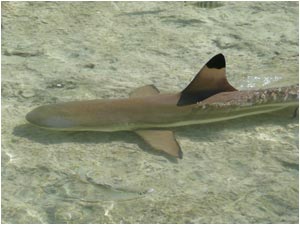
|
|
 |
Day 759 - Fakarava, Tuamotus (S 16° 03 W 145° 37)
19:03hrs - June 28th 2009
Snorkeling Nirvana (Snorvana) |

With my fishing injury well on the way to mended I am back in the water again and enjoying the joys of snorkeling. You’ll be pleased to know my snorkeling skills are somewhat improved (practice makes perfect) and being here, in what for me has to be the snorkeling capital of the world, I am being rewarded with literally the best water, reef, coral and fish that I have ever seen.
The whole experience is perfect, the water is warm enough, the sun is sunny enough and the countless multicolored fish of every size and shape don’t see people much, so they don’t run away when they see you, and apparently the sharks here don’t bite, at least most of them don’t, so I’ve been gaily splashing about every day in this south pacific fishy heaven. In the meantime Neville has been busy getting scuba certified so he can float about far below the surface, something I have still to gather the courage to do. My theory is that all the best light is up on the surface so you get the best view of everything, whereas further below it’s just a bit dark and more importantly much further away from good old fashioned air! So I’ll stick to the surface and my trusty snorkel for now. |
|

| |

|
| |
Click here to see a slide
show of Dream Time’s voyage on ABCNews.com |

| |
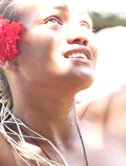 |
| |
View more of our photos
in the Gallery > |
|

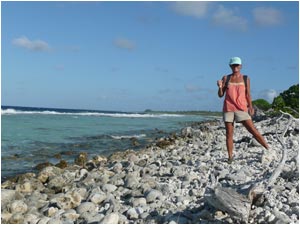
|
|
 |
Day 756 - Fakarava, Tuamotus (S 16° 03 W 145° 37)
16:36hrs - June 25th 2009
A Perfect Passage |

Our exit out of the Makemo atoll, I'm happy to report, was far less dramatic than our entrance. With 2 knots of ebbing current in our favor Dream Time was comfortably swept out of the atoll and back into deep South Pacific waters. With no breaking seas across the entrance, just a few swirling eddies, we shot smoothly out of the atoll with our main sail catching 15 knots of trades, and after clearing the outer reef, unfurled our headsail to begin a fast overnight passage north, up through the Tuamotus to our destination, Fakarava atoll.
Sailing safely through the Tuamotus at night is a relatively new experience for sailors. Once known as the Dangerous Archipelago, prudent captains would avoid the archipelago altogether. The combination on low islands, invisible to mariners until just a few miles away, numerous hidden reefs on unforgiving lee shores, the noise of breaking waves camouflaged by the sound of following tradewinds, strong currents and confused seas, resulted in many vessels foundering along the archipelago's chain of 78 atolls and islands that stretch almost 1,000 miles northwest to southeast. Even the adventurous Thor Heyerdahl's voyage came to a sudden stop not far from Makemo when his vessel, Kontiki, was lost on a reef.
Of course the invention of GPS, chartplotters and radar make cruising the atolls far safer. But even with all the electronic screens glowing reassuringly in the cockpit, at 0200 in the morning, on a black moonless night, when you know you're sailing between two atolls and less than 10 miles away from unforgiving reef and breaking seas, it's still a little unnerving. But the morning sun revealed a faint line of palms on the horizon off our port side and by midday we were anchored off Rotoava village in the northeast corner of Fakarava.
We spent our first day exploring the island, shelling on the windy eastern shoreline and investigating my dive options. Hopefully, by this time tomorrow, I'll be a certified CMAS diver and ready to experience Fakarava's southern passage... underwater. |

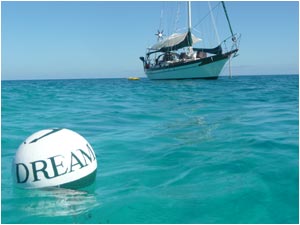
|
|
 |
Day 752 - Makemo, Tuamotus (S 16° 30 W 143° 49)
09:08hrs - June 21st 2009
A Life of Luxury |

For the last week we've been relaxing off a quiet uninhabited island in the northeast corner of the Makemo atoll, and besides the occasional black tip reef shark or giant spotted stingray that swim lazily past the boat, we haven't had a single visitor. There's a steady low rumble of surf breaking on the windward side of the island but inside the lagoon Dream Time rests in flat, crystal clear water, her shadow shimmering on the white sand 30 feet under our keel.
We left the little village of Pouheva last Monday and motored up through the lagoon under an uninterrupted blue sky. With light wind, the sun high and behind us, and with me perched up in the ratlines and Catherine at the helm, we had no difficulty spotting and avoiding the occasional coral patches that dot the lagoon. Rising vertically from the atoll, the submerged coral islands appear like translucent islands of turquoise, brown and white in a sapphire sea. Depths decrease abruptly from a hundred feet to less than three in under a quarter of our boat length. For four hours we meandered our way around the shallows and by early afternoon had settled in to our own little corner of paradise.
With no other cruisers to socialize with and no village on the island to distract us, Catherine and I have settled comfortably into a routine of complete luxury; sunbathing, snorkeling around the dense patches of coral - home to busy communities of hundreds of colorful tiny reef fish. We've cooked over open fires on the beach at night, we've explored the island by day, wandering aimlessly along the shoreline, stopping frequently to gather shells and coral. And while this little corner of Makemo is paradise, there are 78 island and atoll groups that form the Tuamotus just waiting to be explored. So tomorrow we'll up anchor and hopefully, without the same drama as our entrance, slip out the northwest passage for a gentle overnight sail to Fakarava, the second largest atoll in the Tuamotus, where we hope to recruit a Polynesian dive instructor to give us the unique experience of drift-diving through a reef passage at 6 knots with the flooding tide. |


|
|
 |
Day 748 - Makemo, Tuamotus (S 16° 30 W 143° 49)
19:50hrs - June 17th 2009
Fishing 101 - don't hold the line when there's a fish on! |

Now you would think that a person with a tattoo would know better but I’m here to prove otherwise. Picture a quiet sunny morning about 10am, my watch, Neville’s asleep, and I am enjoying those fair winds and calm seas we are always talking about, when I notice birds circling about 500 yards off our port side, and think ahhh there go those fish again! This actually happens quite a lot, and normally nothing else happens. The birds fly off, and the fish swim away, never having come close enough to fall into our cunningly disguised hooks trawling inconspicuously behind the boat. However today was to be different and so with a twang and whizzz something took our bait and shot off taking a surprising amount of line with it. Usually if this happens Neville is happily located close enough to take control of the situation, and while he handles the lines I get the boat ready to deal with the incoming fish, but on this day the fish gods decided to change the dynamic to see what I would do.
The fishing line made a very distinctive whizzing sound as it paid out from the reel and as the fish took more and more line, I couldn’t help thinking about having to pull in all that line, and an furious fish, all the way back to the boat but as I pondered, the fish just kept pulling more and more line out. At this point I decided to surprise Neville and do it all myself so he’d have a lovely fish surprise to wake up to, but as I began to try to reel in what seemed more and more like a whale, I realized I would need some help after all, so as I held firmly onto the rod I turned round and yelled for Neville, but as I waited, whizzing fishing rod in hand, Neville didn’t appear! We had had a tough night watch the night before so I guessed he was still asleep and decided to implement ‘plan B’!
Plan B wasn’t brilliant it has to be said, in fact it wasn’t even actually a plan, rather more a misguided reaction really. I waited for a lull in the whizzing and then with my left hand, quickly grabbed hold of the line at the end of the rod. I’m not exactly sure what I thought was going to happen, but to my great relief it actually stopped whizzing, and for a brief triumphant moment I was victorious, firmly holding the line in my un-gloved left fist, but with a vague worry about how long I would actually have to stand there before Neville woke up and found me. I didn’t have to wait long. Suddenly, without warning and to my enormous surprise the fish took off again and took the line with it. I probably don’t need to tell you what happened next, but for any non-fishing readers I will say that fighting fish are fast, and 60lb test nylon fishing line against skin at high speed is like a hot knife. I let go. The fish whizzed away again, but this time I didn’t try to stop it. I remember looking at my hand as I dashed below to wake Neville for the help I should have asked for 10 minutes ago, but it didn’t register what I had done until Neville was firmly behind the reel pulling in what turned out to be two 20lb Skipjack tuna’s (one on the reel and one on the hand line). The fishing line had sliced into my left index finger at the base, and because the line was so hot it had simultaneously cauterized the cut stopping any bleeding so I was left with a deep bloodless cut that didn’t hurt much….. till later.
All that was a week ago now, and tonight we are anchored in a blissful turquoise coral filled atoll, eating platefuls of perfectly seared tuna. I am however quietly thanking my lucky stars that I still have all my fingers while taking care of a deep but healing cut that is starting to slowly stick together, and although it probably could have done with a few stitches, we are miles from anywhere, and besides it make a great story and it’s going to make an impressive fishing scar! |

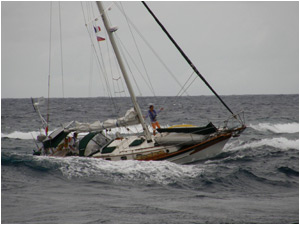
|
|
 |
Day 742 - Makemo, Tuamotus (S 16° 37 W 143° 34)
10:03hrs - June 11th 2009
Running a Pass |

With a cold front fast approaching, forecast to deliver strong winds and 20 foot seas to the area, Catherine and I had only two options; steer Dream Time down one of the three 'evacuation routes' we had plotted on our chart, navigating us out of the labyrinth of coral atolls and into open seas where we would heave-to and weather the storm, affording us with enough room to drift without risk of foundering on a reef. Or enter the Arikitamiro Pass into Makemo Atoll, through an entrance that, because of the building and shifting northwesterly wind - the first signs of the approaching front, was blocked by a barricade of breaking seas.
We timed the end of our 500 mile passage from Nuku Hiva to arrive at Makemo, our first Tuamotu atoll, with first light - hoping to enter the narrow pass between islands and be anchored safely inside for lunch. But when we arrived it was obvious that the tide had already begun ebbing. Makemo Atoll, a giant 40 mile by 10 mile ring of islands and reef was already draining out back into the Pacific and the ripping 8 knot outgoing current colliding with the heavy incoming swell resulted in a spectacular explosion of white water from 8 foot breaking waves. With two other sailboats, Island Buoy and Sentinel who were also trying to enter, we tacked offshore for 7 hours waiting for a slack low tide, the ideal time to run a pass.
But by lunch time, after dodging 30 knot squalls and listening to reports from cruisers already inside the atoll who had heard our radio traffic and were offering their assistance, it was clear that the entrance was still a mess.
At 1330, to get a better perspective, Island Buoy sent one of their crew up the mast. They reported that while breakers still covered much of the entrance, the eastern side of the pass, close to the reef, seemed to have a slight break in the surf. Cruisers ashore had formed a group on the western beach of the pass, providing us with valuable reports of the conditions via handheld VHF radios and, I suspect, to watch the drama unfold should we decide to enter. They too reported that the conditions had improved, but only marginally.
No one wanted to be responsible for claiming the entrance was now passable, so radios fell silent and our three boats hovered outside, captains and crews processing the information and grappling with the anxiety of decision. It was slack tide and clear that the conditions wouldn't improve. A decision had to be made - turn around and run for open water or prepare the boat and enter the atoll.
With life jackets on, washboards up protecting the cabin from breaking waves astern, hatches battened down and our engine thoroughly warmed up, I reported to Island Buoy and Sentinel that we were going in. With Catherine standing defiantly on top of the coachroof to look for shallow water, feet set firmly apart, one hand clutching a stay, the other a halyard, we motored headfirst into the pass and towards the breaking surf.
The photos and video we later received from the cruisers who had watched our approach from the beach do a wonderful job of visually describing how I had imagined the passage would feel - Dream Time being tossed violently around by swirling eddies, disappearing under breaking seas, rolling heavily revealing most of her keel, but the reality of our passage, how it actually felt onboard was far less dramatic than the photos and videos suggest.
Even in the worst surf, Dream Time felt solid and reassuring, her bow sprit never wandering more than a few degrees off track. Spinning the helm and adjusting the throttle, we powered comfortably through, over and around 6 foot breaking seas. And, as if to offer further reassurance, giant dolphins, the biggest we've ever seen, joined our ride into Makemo - somersaulting over crests, surfing off our bow waves, playing with such enthusiasm as if to say, "Hey guys relax, this is fun, enjoy yourselves!" And surprisingly we did.
Last night Dream Time's cockpit was full with cruisers - Kirk, from Salsa, who spent much of the morning providing us with reports from inside the atoll on his handheld VHF radio - cheers mate! Don and Agnes from Honey Moon who filmed our first Tuamotu passage, thanks for capturing the moment! Also, Victor, Mike and Lars from Island Buoy who transited the passage with us and shared their perspective from aloft, and Lynn and Andrew from Sentinel. The drinks flowed as easily as the conversation, experiences were shared and new friends were made.
Catherine and I plan to spend a month cruising the Tuamotus, exploring some of the less visited atolls where we hope to find our own private anchorages and if we're lucky, perhaps even a few Pacific pearls. |

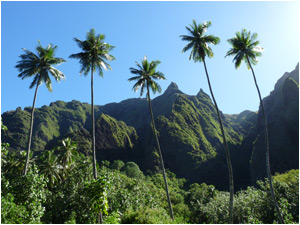
|
|
 |
Day 736 - Nuku Hiva, Marquesas (S 8° 56 W 140° 09)
18:47hrs - June 5th 2009
Leaving the Marquesas |

Tomorrow we leave the Marquesas Islands for points west, but we are leaving with many happy memories of tropical volcanic French loveliness (…….and tattoos!!).
Before we got here I had no real idea what to expect, but each island has been a lovely surprise filled with extraordinarily generous and gracious people with a vibrant connection to their culture and history. Everywhere here, land and sea, is bursting with life and colour, and despite or maybe because of being so very very far away from everything and everyone in the rest of the world, the people here are happy and thriving, but I guess why wouldn’t they be, they really do have their own paradise here.
We spent our last day on Nuku Hiva hiking inland to the highest waterfall in French Polynesia. It was a 2 hour walk that felt part Hansel & Gretel and part Indiana Jones. There were quiet shady sun dappled forests to meander through, and tumbling rivers to leap across and at the end, a 2,000 ft. high cliff face with sparkling water plunging dramatically over the top into a deep chilly pool below, and best of all, we had the place to ourselves. A spectacular and romantic end to our month long tour of these beautiful Marquesas Islands.
4 days and 500 miles to the next stop, the Tuamotu’s. |


|
|
 |
Day 732 - Nuku Hiva, Marquesas (S 8° 54 W 140° 06)
09:12hrs - June 1st 2009
Lucky to be Here |

We've been exploring the Marquesas for one month now, jumping from island to island like stepping stones, working our way north through the chain. But we've reached the end of our journey here. For three days we've been anchored in Taiohoa Bay in Nuku Hiva - the largest island in the Marquesas and the last one we'll be visiting. Taiohoa Bay is the 'capital' of the Marquesas and is where, back in 1842 at the rebellious age of 23, Herman Melville jumped the whaling ship Acushnet and wrote about his exploits in his first book, Typee. After being anchored in the bay for three days I'm beginning to understand why old Herman decided to abandon ship here. Taiohoa Bay provides little protection to the southerly swell and in slack wind boats at anchor drift around, laying beam to the waves, rolling heavily - masts swinging across the sky in great sweeping 50 degree arcs. If it wasn't for the stern anchor we threw out, holding Dream Time in place to face the onslaught of waves head-on, Catherine and I would have jumped ship two days ago.
Compared to the other secluded bays we've visited in the Marquesas, Taiohoa is a bustling harbor. Over 40 sailing boats are anchored here along with the Regent cruise ship, Paul Gauguin, and yesterday we were even graced with the presence of the 200+ foot royal luxury Spanish yacht, Nirvana. There's such a wide spectrum of sailors here, and while I'm sure each of them has their own fascinating story to share about how they got here, one sailor in particular, like Melville, really does have an epic story to tell.
Surviving 56 days at sea with no engine, no electrical power, hand steering and manually pumping the bilge 2 minutes out of every 8 - day and night to stay afloat, sounds more like a Thor Heyerdahl adventure, but it's not, it's the story of how Sylvain made it to the Marquesas. A Canadian cruiser, Sylvain sailed in to the harbor early Friday morning, running before gusts of 38 knots of wind under a storm trisail flying from his wooden spars before anchoring his weathered, 1962 wooden ketch, Inherit The Wind, next to Dream Time. We made the usual customary introductions from dinghies and ended up spending most of the day together, listening to his story whilst running cruiser errands around town - topping up diesel jerry cans, finding butane to fill our gas tanks, and provisioning. The longer we spent with Sylvain the more fascinating his story became. Sharing the details of his experience over lunch in a casual, matter-of-fact way, remembering and reliving a particularly noteworthy moment with a smile, chuckle and incredulous shake of his head, Sylvain's attitude, I suspect, was what helped him survive.
He wasn't alone in his suffering, he openly admits that if he was he wouldn't have had the strength to pump the bilges for so long. No, it was his crew of two that helped him hold on to his sanity, and his boat. A 21-year old Irish lad with no sailing experience (who I suspect didn't know any better) joined Sylvain in Costa Rica and consequently, after surviving the crossing, jumped ship at the first opportunity he got in Hiva Oa. His second member of crew, Eddie, looks as weathered at Sylvain and has been a loyal friend and sailing companion for eight years. At 15 years old, Eddie, a Jack Russel, sits protectively at Sylvain's side gnawing on a lump of bone.
It would be easy to dismiss Sylvain's story as perhaps another tall sea yarn told by an overenthusiastic and imaginative sailor, but during glasses of Nicaraguan rum on Inherit The Wind Saturday evening, hearing the automatic bilge pump come to life every 5 minutes and seeing the floorboards in his cabin torn up, revealing broken wooden ribs and worn planking underneath allowing a steady trickle of water to ooze in through the seams, this is one sailing story that I know must be true.
We had planned to leave today and sail west along the coast to Hakauio Bay, our last anchorage in the Marquesas and site of the world's third tallest waterfall, but it's our anniversary, today Catherine and I have begun our third year living aboard Dream Time. So it's a day of rest, of reflection and like Sylvain, a day to consider how lucky we are to even be here. |

|
|





![]()